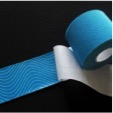What is Kinesio Tape?
August 27, 2015
Coming Soon…

If you have watched any sporting events, you may have seen some athletes wearing that crazy sports tape on their shoulders, knees, ankles, or any other part of their body. You may have wondered what is that stuff and what does it do? Well wonder no more, the tape you see on Olympiad Kerri Walsh’s shoulder is called Kinesio Tex tape (KT tape, for short).
The history of KT tape may surprise you. It began in Japan, Dr. Kenzo Kase first developed the Kinesio taping method in 1979 (over 35 years ago!). He is a chiropractor as well as a licensed acupuncturist. Dr. Kase realized that manual therapy (i.e., massage therapy, chiropractic care, and physical therapy) was extremely effective for the treatment of different ailments, but often the effects were short lived. He sought out for something his clients could use between appointments to increase the effectiveness of manual therapy for longer lasting results. The Kinesio taping method was introduced to the United States in 1995, and then Europe in 1996. However, it wasn’t until 2008, when Kerri Walsh was seen with the tape did it become popular in the States.

So what does the KT tape method do? Kinesiology taping is based on the body’s own natural healing process. Unlike conventional athletic tape, kinesiology tape has elastic properties and does not restrict movement. It is made of 100% elastic fibers that are latex free. You may notice a wave-like pattern, which is put on the tape to mimic fingerprints and allows the tape to breathe. The amount of stretch in this tape correlates with the elastic qualities of our skin and its special properties aid our proprioceptors and lymphatic system. When applied correctly, kinesiology tape can be used to treat:
- Acute and chronic pain
- Swelling/edema (https://www.kinesiotaping.com/images/kinesio-association/pdf/research/2007-5.pdf)
- Myofascial tightness (https://www.manualtherapyjournal.com/article/S1356-689X(09)00147-7/pdf)
- Provides joint alignment/stability (https://www.ncbi.nlm.nih.gov/pubmed/18001897)
- Over-active muscles
- Bruising

Can anybody use the KT tape method? The success of this tape is dependent on proper examination and application. Therefore, it is best to see your favorite physical therapist for the assistance of proper application. Different techniques are used for each unique objective. Are you trying to relax a tight muscle, assist a weak muscle, decrease pain or swelling, or support a joint? To be truly effective, a practitioner needs to know exactly why the tape is being applied. Having this information determines joint/muscle positioning for taping and determines the amount of tension and in what direction it is applied. Here at Superior Physical Therapy and Sports Rehab (www.frederickpt.com), we are trained in using the KT tape method for orthopedic and neurological issues and would love to help you get back your function in a safe and supported manner.